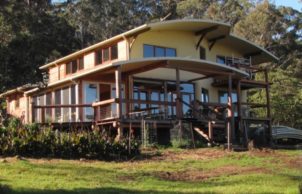Kurrajong Hill
Kurrajong Hill
Our two-storey home, with 50km of views over National Parks to the South East Ranges, took four years to build to 2010. The strawbale walls rendered internally with clay and finished with clay paints have been very successful. With external render of lime/sand and a durable mineral paint finish, the walls are hygroscopic, giving a comfortable atmosphere and balanced humidity.
The rammed-earth components add to the thermal mass to help keep temperatures stable. More thermal mass is provided by the masonry heater, a great addition and far superior to any other form of wood heater. The masonry heater provides all the pleasures of wood burning but eliminates the downside. It keeps the air and environment clean both inside and outside the home, uses less wood and requires little labour.
We built a sun room on the north side, which adds warmth in winter and insulates the house in summer. Passive features also include under-floor ventilation in summer.
We were familiar with the disciplines of using solar power, but our 4KW, 1200 amp-hour 48-volt system enables us to use electrical appliances freely through most of the year; only mid-winter requiring us to be more frugal. Nevertheless, we need a backup generator for times of gloomy weather.
We cook on a wood-fired Rayburn, but also use gas for convenience. Our masonry heater has an oven which offers an extra dimension to our cooking. The Rayburn augments the evacuated tube solar hot water heater in winter.
We installed a Clivus Multrum for the composting toilets, which have given a huge saving in water, all of which comes from the roofs of house and sheds into nine plastic tanks of 250000 litre total capacity. Greywater is recycled into growing areas and the compost feeds the garden.
We are still developing our gardens, and have completed an orchard/chook yard, soft-fruit enclosure and a pond. We are constructing a terraced vegetable garden near the house, where we also continue ornamental planting of both natives and exotics. We have chosen fire retardent plants where possible and have an ember barrier planting to aid in case of bushfire.
We have opened our home for Sustainable House Day since 2012 and are pleased to meet our visitors and discuss what works for us.
For directions to get to this home from Princes Highway, please see this map to Kurrajong Hill.





Ask questions about this house
Load More Comments